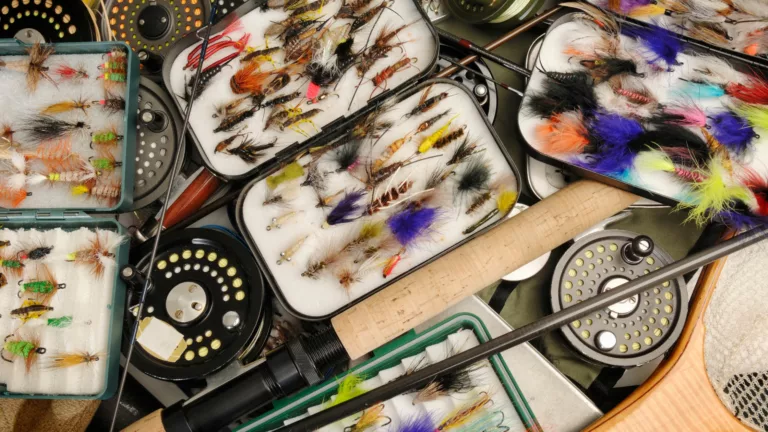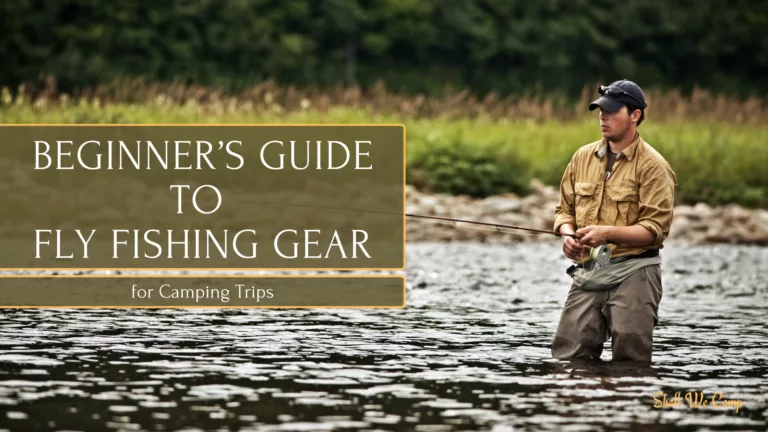Combining fly fishing with camping is one of the most rewarding ways to explore the great outdoors. But before you cast your first line beside a quiet stream or lake, it’s important to have the right gear on hand. Fly fishing requires a unique setup, different from traditional fishing and when you're out in nature for days at a time, preparation is everything.
The right fly fishing gear can turn a good camping trip into an unforgettable outdoor experience.
This guide will walk you through the essential fly fishing equipment to bring on your next camping trip, whether you’re just starting out or brushing up on the basics.
Affiliate Disclaimer: This site contains affiliate links, which means I may earn a commission on purchases made through these links at no extra cost to you.
Table of Contents
Essential Equipment for Fly Fishing and Camping
Many beginners find it helpful to start with a mid-weight fly rod that gives a balanced feel on the water. This type of rod is adaptable for various species and water conditions. Investing in quality gear increases your enjoyment and provides you with durability during those unpredictable outdoor trips. It really pays to be prepared with a bit of extra equipment when the weather suddenly shifts. Over time, as you become more comfortable, you might experiment with different rod sizes and materials to better match the conditions you encounter.
Speaking of high performance, a good reel complements the fly rod by providing a smooth drag system and quick retrieval of your lines. Combining these with a well-matched fly line, leader, and tippet set helps with precision casts and successful hook-ups.
Getting Ready for the Water: An Overview of Must-Have Items
Before heading out, taking a detailed look at your gear list is a worthwhile step. Beginners may sometimes overlook the importance of smaller accessories because they focus solely on the rod and reel. However, items like fly boxes, landing nets, and a waterproof vest can really make your trips far more efficient.
- Fly Rod – Opt for an 8 weight, standard 9 foot rod
- Reel – Brands like Orvis, Sage, and Redington offer great options for beginners
- Fly Boxes – Keeps your assortment of flies organized
- Landing Net – Helps you safely bring in your catch with minimal damage to the fish and your equipment
- Waterproof Vest – Perfect for holding your extra flies, tippets and small tools
These accessories add convenience and efficiency, allowing you to focus more on enjoying the experience rather than worrying about basic organization. With each trip, understanding how these little additions work together enhances your capability in unpredictable outdoor scenes.
The Fundamentals of Fly Fishing Gear for Camping
A natural camping environment often comes with uneven terrain and sudden weather changes. This is why portable, durable, and multifunctional equipment becomes very important. The right mix of gear can help you adapt to conditions whether you are selecting a secluded riverbank or a stocked lake. It is always a smart idea to pack items that serve multiple purposes. For example, a sturdy bag that carries your gear can also double as extra storage when the weather turns rainy.
My favorite setup includes a robust yet lightweight fly rod, a smooth-operating reel, and a fly line suitable for mid-range casts. Each element is chosen based on its ease of use during extended sessions, performance in windy conditions, and readiness in a sudden downpour. It is worth checking your equipment before each trip and periodically updating your kit as your skills progress.
Many seasoned fly fishers recommend mid-length rods between 8 to 9 feet for camping trips. The extra reach is useful in waters with various depths and under challenging wind conditions. Finding the best match for your personal fishing style might involve a bit of trial and error. With continued practice, the feel of a particular rod, coupled with the perfect reel, can become an extension of your own instinct on the water.
Steps to Set Up the Perfect Fly Fishing Camp
When choosing your fishing spot, consider factors such as water clarity, depth, and current. These elements influence the types of flies you might want to bring along. For example, in clear, slow-moving streams, delicate dry flies might yield the best success. In contrast, murky water might favor nymphs or streamer patterns that stand out and can be seen easily by fish. Taking time to research or even talk to local anglers beforehand can provide insights specific to your chosen location.
Additionally, setting up camp close to the water can allow you to store gear securely. Using a weather-resistant container or bag to keep rods and reels safe from moisture is extremely practical. Often, I pack an extra dry bag for essential items like matches, snacks, and sensitive electronic devices.
Tips on Gear Upkeep

Regular cleaning of your fly line using mild soap and water helps maintain its performance over time. It is also a good idea to dry your rods and reels thoroughly after each trip to prevent corrosion. This step prolongs the life of your equipment and makes sure that every fishing trip is ready with reliable gear. Additionally, carefully checking your flies for any signs of damage and replacing worn or broken ones can significantly improve your success rate.
Conditioning your reels with a light oil allows operations such as wind-on and drag to continue functioning smoothly. Using a soft cloth to remove any salt or dirt buildup after days spent by either freshwater or brackish water is definitely recommended. These small steps will help you avoid costly repairs later and keep your equipment in top-notch shape for upcoming adventures.
Advanced Tips for Seasoned Fly Fishers
For those who already have a solid foundation in fly fishing and camping, pushing your gear and skills further can be fun and even lead to more successful outings. Advanced fly fishers often incorporate specialized accessories that focus on performance and efficiency.
Experiment with different fly patterns:
Some fly fishers opt to carry two sets of flies: one collection tailored for early morning dry fly fishing and another set focused on nymphs for midday sessions. Fine-tuning your selection based on fish behavior and weather conditions moves you beyond the beginner basics into a more detailed approach to the sport.
Adjust casting techniques:
Learn how to adjust your casting techniques for wind and current. Fine adjustments in your grip, your casting angle, and the pause between casts allow you to improve overall accuracy and confidence. Coupling these refined techniques with an upgraded rod and reel that offer better control will help you make the most of every casting opportunity. Seasoned anglers often spend years perfecting these minor adjustments, and each trip offers a chance to level up your skills further.
Upgrade your gear:
Staying informed about innovative gear releases is another area advanced enthusiasts pursue. Although it is important to stick with trusted equipment, keeping an eye on new models and technologies designed specifically for fly fishing can provide a next-level cool advantage. Reading industry publications and expert reviews can give you insights that may inspire you to update your kit.
Additional Insights and Extended Advice

Spend extra time planning your schedule, mapping out the best fishing spots in the area, and even coordinate with other fishing enthusiasts. Sometimes, the smallest details, such as the way you pack your gear or the order in which you set up your campsite, can make a significant difference on the overall success of your day.
It can be really helpful to take notes during each trip. Recording details about the weather, water conditions, and the performance of each piece of equipment provides a personal log that can be referred to in future outings. Over time, these observations help you identify patterns and refine your techniques further. Whether you keep a digital log or a handwritten journal, the effort you put into tracking your experiences pays off when you are faced with new challenges on the water.
Many experienced anglers also recommend joining local fly fishing clubs or online forums where ideas and experiences are exchanged. Such communities can provide advice on everything from the best local fishing spots to troubleshooting gear issues. There is a strong sense of camaraderie in sharing both tips and stories, which enriches every aspect of the fly fishing adventure.
Another point to consider is the value of periodically reviewing the latest techniques taught by expert anglers through workshops or online classes. Continuous learning is truly very important as it allows you to keep pace with new methods and innovations in gear maintenance and setup. You might learn about a new casting technique or a new approach to selecting flies.
Frequently Asked Questions
Question: What rod and reel combination is best suited for camping trips?
Answer: A mid-weight fly rod around 8 to 9 feet paired with a reel that offers a smooth drag is typically a good starting point. This combination works well in a range of water conditions, from fast rivers to calm lakes.
Question: How many types of flies should I bring on a camping trip?
Answer: Bringing a variety of flies can really increase your chances. It might be a smart idea to pack a small assortment that includes dry flies, wet flies, and nymphs. This way you can quickly switch up your approach based on the situation you encounter on the water.
Question: What are some tips for maintaining gear when camping near water?
Answer: Keeping your equipment clean and dry is very important. After each session, rinse your fly rod and reel with fresh water and store them in a dry bag. Also, check your flies and tippets for any signs of wear or damage before your next outing.
Question: Any advice for setting up camp near the fishing spot?
Answer: Choose a location that is close to the water while also being safe from sudden floods. A dry, flat area makes an ideal site, and having a secure place to store sensitive gear like reels and extra flies can prevent damage from unpredictable weather changes.






